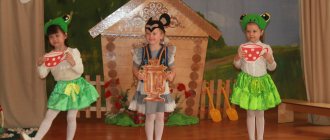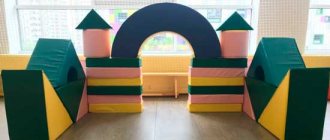Formation of a holistic picture of the world in children of senior preschool age
Dear friends, we are pleased to introduce you Tamara Vladimirovna Dobrynina, senior teacher of the first qualification category of MKDOU kindergarten No. 356 in the city of Novosibirsk. Today Tamara Vladimirovna is happy to share with us her professional experience in forming a holistic picture of the world in children of senior preschool age through experimentation and practical activities. The article will be of interest to preschool teachers and parents.
Comment to the article from Tamara Vladimirovna:
“One of the integrative qualities of a preschooler in accordance with the Law “On Education” and FGT is inquisitive and active, it is these qualities that develop as the child masters experimental activities, which must be integrated with other educational areas. Today I would like to share my experience in this area.”
Useful reading...
Formation of a holistic picture of the world in children of senior preschool age
through experimentation and practical activities
Preschoolers are distinguished by their amazing curiosity and willingness to learn. But these positive qualities often conflict with their lack of skills in cognitive and research activities.
Research by teachers and psychologists A.V. Zaporozhets, N.N. Podyakova, P.Ya. Galperina show that the productivity of mastering knowledge and certain personality traits depends on how the learning process is organized and on the position of the child himself, on his activity.
In modern times, it is very important to raise a person who knows how to think, capable of analysis, introspection, self-development, self-education, who is able to apply acquired knowledge in joint activities with peers and in independent activities.
And updating the content of education directs us, teachers, to search for effective and adequate forms of teaching, methods and techniques for preschool age.
Based on this, in our work we strive to form in preschoolers elementary ideas about a holistic picture of the world; develop cognitive activity, curiosity, and the desire for independent knowledge of the phenomena of the surrounding world.
The following tasks are subordinated to achieving this goal:
- teach different ways of knowing,
- form basic ideas about the world around us,
- develop cognitive activity.
Necessary conditions for the successful implementation of these tasks are:
1. Personality-oriented model of interaction between an adult and a child.
2. Activity approach.
3.Use the principle of integration of educational areas and various types of children's activities.
4. Organization of a special subject-development environment.
5.Well, and, of course, the active participation of parents in the educational process.
The novelty of the experience lies in the fact that we strive to act in the logic of an integrative approach and use modern educational technologies, thereby implementing FGT.
The emphasis is shifted to learning the ability to independently obtain the necessary information, identify problems, set tasks, find ways to solve them rationally, analyze the knowledge gained and apply it in practice. The solution of program problems is provided within the framework of direct educational activities and in the organization of routine moments - both in the joint activities of adults and children, and in the independent activities of a preschooler.
When implementing the content of the educational area “Cognition”, we use the following, in our opinion, the most effective methods and techniques.
Experiment. Experimentation is organized as an active activity for children. At the same time, each child should be able to explain: what he wanted to know, how he found out, how he checked, what happened. The research is organized based on the motive and needs of the children. The teacher’s task at this stage is to help realize this need.
By the way, as part of the experiment we use a demonstration of tricks. Magic tricks are generally attractive to children, and scientific tricks also solve a number of problems. After the trick comes a certain “point of surprise” - an extremely important moment in the child’s life. This is an attempt to explain the phenomenon seen.
Closely related to experimentation is another general scientific method of cognition – modeling.
And a model experiment allows us to study such phenomena, objects on which direct experiment is difficult, for example, modeling processes occurring in space, modeling some natural phenomena.
In addition to the model experiment, modeling is divided into graphical modeling, subject modeling and effective modeling.
We propose to consider the most significant, in our opinion, ways of working with models.
Graphic modeling. Of particular interest is the work on interesting algorithms. As practice has shown, algorithms provide great assistance when conducting research activities. In general, the stages of any activity can be translated into graphic symbols. The important thing is that algorithms can be used both in joint activities of a child and an adult, and in the independent activities of a preschooler as a guide.
In addition, we widely use effective modeling - these are games with layouts that display the characteristics of natural and climatic zones, objects and phenomena occurring in space.
One of the promising methods that promotes the development of cognitive interest and the formation of cooperation skills is the implementation of projects. The project is based on an idea and its solution requires research in various directions, the results of which are generalized and combined into one whole. Through the combination of various types of activities, various areas of knowledge, a holistic vision of the picture of the surrounding world is formed. The preschool educational institution implements various projects, for example: “Forest Dwellers”; “Everyone needs our care”; “Wonderful basket”; “Journey to the underwater kingdom”, “What is water for”, etc.
To support the educational process, our preschool educational institution uses ICT technologies, namely, educational presentations and videos. Such computer products are of great interest to children.
In addition, the educational process is built in the logic of an integrative approach.
Thus, the specific tasks of the educational field “Cognition” are solved in the course of implementing the content of such educational fields as:
Communication is the formation of a holistic picture of the world and broadening one’s horizons in the process of free communication with peers and adults.
Reading fiction is the formation of a holistic picture of the world and broadening one’s horizons in the process of perceiving fiction.
Socialization is the formation of a holistic picture of the world and broadening one’s horizons in terms of ideas about oneself, family and society, the state, and the world.
Work is the formation of a holistic picture of the world and broadening one’s horizons in terms of ideas about the work of adults and one’s own work activity.
Health – expanding children’s horizons in terms of ideas about a healthy lifestyle.
Safety is the formation of a holistic picture of the world and broadening one’s horizons in terms of ideas about the safety of one’s own life and the safety of the surrounding natural world.
Music and artistic creativity - the formation of a holistic picture of the world, broadening one’s horizons in terms of musical and visual arts.
Thus, the solution to the assigned tasks is carried out not by dividing into separate components of the learning process, but integratively, through interaction, interpenetration of methods and techniques, educational areas and various types of children's activities. The project method can be presented as a way of organizing the pedagogical process, based on the interaction between teacher and student, a way of interacting with the environment, and step-by-step practical activities to achieve a set goal.
are clearly defined :
• presentation of a situation that allows you to identify one or more problems on the topic under discussion;
• identification of hypotheses; discussion and justification of each of the hypotheses;
• discussion of methods for testing accepted hypotheses in small groups;
• work in groups to search for facts, arguments confirming or refuting the hypothesis;
• registration of results;
• protection of projects of each group;
• putting forward a new problem;
The main goal of the project method in a preschool educational institution is the development of the child’s free creative personality, which is determined by the developmental tasks and objectives of the children’s research activities.
Development objectives:
• Ensuring the psychological well-being and health of children;
• Development of creative imagination;
• Development of creative thinking;
• Development of communication skills.
Each stage of innovation activity requires teachers to have developed adequate professional competencies and a readiness to perceive innovation. To acquire professionalism, you need appropriate abilities, desire and character, a willingness to constantly learn and improve your skills. As one of the most important components of professional competence A.K. Markova calls the ability to independently acquire new knowledge and skills, as well as use them in practical activities, the process of self-education.
The preparedness of teachers to master innovations includes: awareness of innovations, the presence of needs for changes and renewal of the pedagogical process; their motivation to develop and master innovations; availability of systemic knowledge and skills for the successful implementation of professional and research activities.
Bibliography:
- E.A. Martynova, I.M. Suchkova /Organization of experimental activities for children 2-7 years old//Uchitel Publishing House, 2013/ Volgograd
- M.P.Kostyuchenko / Research activities on walks // Uchitel Publishing House, 2013 / Volgograd
- G.B.Gorbasheva / Organization of experimental activities for preschool children // M.: ARKTI, 2010
- A.G. Madera, A.P. Pyatikop /Experiments without explosions// Karapuz, 2000




